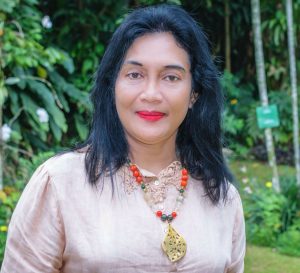Social and ecological impacts after normalization of the Banjir Kanal Barat River for communities around North Semarang
Downloads
In 2010, the Semarang government normalized the Banjir Kanal Barat River by dredging and widening the river and managing spatial planning by adding a waterfront. The purpose of normalization is to increase the water discharge capacity so that it can accommodate water flow from three rivers (the Kreo River, the Kripik River, and the Garang River). The focus of this study is to identify social and ecological impacts after the normalization of the BKB River. This study uses qualitative methods with data collection techniques carried out through observation, in-depth interviews, and documentation. The informants in this study numbered seven people, consisting of officers (managers of the BKB Weir and cleaning officers), RW heads, the community, and visitors. The results showed the impact on social aspects, namely that the community has new public spaces, brings economic opportunities, strengthens social solidarity through river mutual aid activities, and, after normalization, the BKB River area becomes prone to crime because the streets are quiet plus there is poor lighting. The ecological impact is the use of land on the banks of the BKB River for fish farming and agriculture. People's behavior in seeing rivers is formed from the interactions they carry out at the individual level, so people have various perceptions in looking at the river, as mentioned above.
Abdussamad Z (2021) Metode Penelitian Kualitatif. Rapanna P (ed). Gorontalo: Syakir Media Press.
Arni (2021) Makna hutan bagi masyarakat adat Ammatoa dari perspektif interaksionisme simbolik. Jurnal Komunikasi dan Organisasi (J-KO) 3 (1):9-19.
Arofah RU, Max RM, & Jati OE (2018) Hubungan antara tekstur sedimen, kandungan bahan organik dan kelimpahan makrozoobenthos diperairan muara Banjir Kanal Barat, Semarang. Management of Aquatic Resources Journal (MAQUARES) 7 (4): 387-388.
Azizi MA, Mulyadi, Amiruddin, Andriani P, & Islamy A (2022) Cadar dan tantangan sosial: Studi fenomenologi atas kewajiban penggunaan cadar bagi santriwati Ma`hadal Ulum Diniyah Islamiyah Bireuen Aceh. Alhadharah: Jurnal Ilmu Dakwah 21 (1):1-13. https://doi.org/10.18592/alhadharah.v21i1.6253.
Budoyo NP & Suwandono D (2014) Perencanaan pasar apung berkelanjutan dalam upaya pengembangan kawasan wisata air Banjir Kanal Barat Kota Semarang. Ruang 2 (4):321-330.
Chadijah DI (2017) Keberlanjutan ekologis hutan dalam kearifan lokal Panglima Uteun pada masyarakat Nagan Raya. Jurnal Analisa Sosiologi 6 (2):1-17.
Ching L & Mukherjee M (2015) Managing the socio-ecology of very large rivers: Collective choice rules in IWRM narratives. Global Environmental Change 34: 172-184. https://doi.org/10.1016/j.gloenvcha.2015.06.012.
DP RHD & Martini R (2014) Implementasi kebijakan pengelolaan Sungai Kanal Banjir Barat atau Kaligarang di Kota Semarang. Journal of Politic and Goverment Studies 4 (1):126-135.
Haddade H (2016) Air perspektif Al-Qur'an dan sains. Tafsere 4 (2):17-30.
Hakam AM (2018) Evaluasi proses kebijakan penanganan banjir rob di Kota Semarang oleh pemerintah Kota Semarang. Thesis, Universitas Diponegoro, Semarang.
Kismartini K, Kurniawan H, & Dwika SAP (2018) Strategi pengembangan Banjir Kanal Barat sebagai daya tarik wisata di Kota Semarang. Jurnal Ilmu Sosial 17 (1):64-76.
Koundouri P, Rault PK, Pergamalis V, Skianis V, & Souliotis I (2016) Development of an integrated methodology for the sustainable environmental and socio-economic management of river ecosystems. Science of the Total Environment 540: 90-100. https://doi.org/10.1016/j.scitotenv.2015.07.082.
Kumalasari LD (2017) Makna solidaritas sosial dalam tradisi "Sedekah Desa” (Studi pada masyarakat Desa Ngogri Megaluh Jombang). Research Report, 1110-1123.
Kusumaning T & Feronika SP (2014) Kajian strategi penanganan banjir/rob di Pelabuhan Tanjung Emas Semarang. Warta Penelitian Pembangunan 26 (11):677-688.
Mokodongan BK, Sela RLE, & Karongkong HH (2014) Identifikasi pemanfaatan kawasan bantaran sungai dayanan di Kotamobagu. Sabua 6 (3):273-283.
Murniningsih S & Mustafa AG (2019) Analisis dampak normalisasi sungai terhadap erosi dan sedimentasi di daerah perkotaan studi kasus: Sungai Pesanggrahan, Jakarta. Indonesian Journal of Construction Engineering and Sustainable Development (Cesd) 2 (2):54-59.
Musthofa ZA, Husamah H, Hudha AM, Muttaqin T, Hasanah I, & Setyawan D (2017) Mengurai Sengkarut Bencana Lingkungan (Refleksi Jurnalisme Lingkungan dan Deep Ecology di Indonesia). Malang: Umm Press Dan Pslk Umm.
Nanda CA, Nugraha AL, & Firdaus HS (2019) Analisis tingkat daerah rawan kriminalitas menggunakan Metode Kernel Density di wilayah hukum Polrestabes Kota Semarang. Jurnal Geodesi Undip 8 (4):50-58.
Niadi MUY, Yenrizal, & Saputra S (2023) Komunikasi lingkungan dalam pelestarian alam (Studi pada tradisi bekarang di Desa Jiwa Baru Kabupaten Muara Enim). Jurnal Studi Ilmu Komunikasi 2 (1):43-45.
Nurawaludin I & Susetyaningsih A (2021) Evaluasi penanganan dampak lingkungan pembangunan terowongan Nanjung di Kabupaten Bandung. Jurnal Konstruksi 19 (2):373-382.
Nurmala Y & Taher A (2018) Pemaknaan terhadap pemanfaatan hutan Burni Telong sebagai hutan produktif oleh masyarakat (Studi di Desa Rembune Kecamatan Timang Gajah Kabupaten Bener Meriah). Jurnal Ilmiah Mahasiswa FISIP Unsyiah 3 (1):1-13.
Pratiwi D, Sinia RO, & Fitri A (2020) Peningkatan pengetahuan masyarakat terhadap drainase berporus yang difungsikan sebagai tempat peresapan air hujan. Journal Sosial Science and Teknology for Community Service 1 (2):17-23.
Prayojana TW, Mardhatil, Fazri AN, & Saputra B (2020) Dampak urbanisasi terhadap pemukiman kumuh (Slum area). Jurnal Kependudukan dan Pembangunan Lingkungan 1 (2):13-22.
Purnamasari VN, Agnes FW, & Kuswanto (2014) Analisis kandungan timbal (Pb) dan laju konsumsi aman pada kepiting bakau (Scylla serrata forskal) di Sungai Donan Cilacap. Jurnal Kesmasindo 6 (3):157-165.
Puspitasari RA, Setioko B, & Pandelaki EE (2015) Persepsi integrasi tata guna lahan pada kawasan waterfront development (Studi kasus: Kanal Banjir Barat Semarang). Teknik 36 (1):17-23.
Rahmah W (2017) Dampak sosial ekonomi dan budaya objek wisata sungai hijau terhadap masyarakat di Desa Salo Kecamatan Salo Kabupaten Kampar. Jurnal Online Mahasiswa (JOM) Bidang Ilmu Sosial dan Ilmu Politik 4 (1):1-16.
Ramadhan I, Dewantara JA, Efriani E, Olendo YO, & Bafadal MF (2020) Waterfront sebagai modal sosial ekonomi masyarakat di tepian sungai kapuas. ETNOREFLIKA: Jurnal Sosial Dan Budaya 9 (3):213-25. https://doi.org/10.33772/etnoreflika.v9i3.877.
Sari DA, Haeruddin, & Rudiyanti S (2016) Analisis beban pencemaran deterjen dan indeks kualitas air di Sungai Banjir Kanal Barat, Semarang dan hubungannya dengan kelimpahan fitoplankton. Management of Aquatic Resources Journal (MAQUARES) 5 (4):353-362.
Sidqi FA (2016) Pengelolaan sungai menurut Peraturan Daerah Kota Banjarmasin N0 2 Tahun 2007. Al'Adl 8 (2):85-98.
Subangkit A (2017) Perubahan sosial warga bukit duri pasca normalisasi Sungai Ciliwung. Thesis, Universitas Islam Negeri Syarif Hhidayatullah Jakarta, Jakarta.
Suliyati T (2014) Penataan drainase perkotaan berbasis budaya dalam upaya penanganan banjir di Kota Semarang. HUMANIKA 19 (1):59-69.
Wardani DAK, Dewi NK, & Utami NR (2014) Akumulasi logam berat timbal (Pb) pada daging kerang hijau (Perna Viridis) di Muara Sungai Banjir Kanal Barat Semarang. Life Science: Journal of Biology 3 (1):1-8.
Widiantara IWA, Nurman SH, & Adani M (2020) Potensi Wisata di Bantaran Sungai Banjir Kanal Barat Semarang. MODUL 20 (1):49-56.
Widyanti P, Kismartini, & Maesaroh (2014) Implementasi kebijakan penanggulangan banjir (Studi kasus proyek normalisasi Banjir Kanal Barat dan Kali Garang Kota Semarang. Journal of Public Policy and Management Review 3 (3):123-131.
Zain IAA (2022) Arah penataan dan pengembangan konsep waterfront city pada objek wisata Pantai Soge Pacitan. Journal Economicand Strategy 3 (1):70-85.

This work is licensed under a Creative Commons Attribution-NonCommercial-ShareAlike 4.0 International License.
1. Copyright of this journal is possession of Editorial Board and Journal Manager, by the knowledge of author, whilst the moral right of the publication belongs to the author.
2. Legal formal aspect of journal publication accessibility refers to Creative Commons Attribution-NonCommercial-ShareAlike (CC BY-NC-SA), implies that publication can be used for non-commercial purposes in its original form (cannot be modified).
3. Every publications (printed/electronic) are open access for educational purposes, research, and library. Other that the aims mentioned above, editorial board is not responsible for copyright violation.















